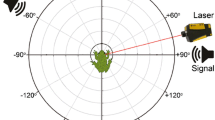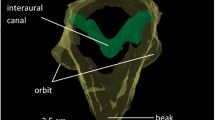Abstract
In the cricket ear, sound acts on the external surface of the tympanum and also reaches the inner surface after travelling in at least three pathways in the tracheal system. We have determined the transmission gain of the three internal sound pathways; that is, the change of amplitude and phase angle from the entrances of the tracheal system to the inner surface of the tympanum. In addition, we have measured the diffraction and time of arrival of sound at the ear and at the three entrances at various directions of sound incidence. By combining these data we have calculated how the total driving force at the tympanum depends on the direction of sound. The results are in reasonable agreement with the directionality of the tympanal vibrations as determined with laser vibrometry.
At the frequency of the calling song (4.7 kHz), the direction of the sound has little effect on the amplitudes of the sounds acting on the tympanum, but large effects on their phase angles, especially of the sound waves entering the tracheal system at the contralateral side of the body. The master parameter for causing the directionality of the ear in the forward direction is the sound wave entering the contralateral thoracic spiracle. The phase of this sound component may change by 130–140° with sound direction. The transmission of sound from the contralateral inputs is dominated by a very selective high-pass filter, and large changes in amplitude and phase are seen in the transmitted sounds when the sound frequency changes from 4 to 5 kHz. The directionality is therefore very dependent on sound frequency.
The transmission gains vary considerably in different individuals, and much variation was also found in the directional patterns of the ears, especially in the effects of sounds from contralateral directions. However, the directional pattern in the frontal direction is quite robust (at least 5 dB difference between the 330° and 30° directions), so these variations have only little effect on how well the individual animals can approach singing conspecifics.
Similar content being viewed by others
Abbreviations
- CS:
-
contralateral spiracle
- CT:
-
contralateral tympanum
- IS:
-
ipsilateral spiracle
- IT:
-
ipsilateral tympanum
- P:
-
the vectorial sum of the sounds acting on the tympanum
References
Autrum H (1940) Über Lautäusserungen und SchallWahrnehmung bei Arthropoden. II. Das Richtungshören von Locusta und Versuch einer Hörtheorie für Tympanalorgane vom Locustidentyp. Z Vergl Physiol 28: 326–352
Boyan GS (1979) Directional responses to sound in the central nervous system of the cricket Teleogryllus commodus (Orthoptera: Gryllildae). I. Ascending neurons. J Comp Physiol 130: 137–150
Boyd P, Lewis B (1983) Peripheral auditory directionality in the cricket (Gryllus campestris L., Teleogryllus oceanicus Le Guillou). J Comp Physiol 153: 523–532
Fletcher NH, Thwaites S (1979) Acoustical analysis of the auditory system of the cricket Teleogryllus commodus (Walker). J Acoust Soc Am 66: 350–357
Hill KG (1974) Carrier frequency as a factor in phonotactic behaviour of female crickets Teleogryllus commodus. J Comp Physiol 93: 7–18
Hill KG, Boyan GS (1976) Directional hearing in crickets. Nature 262: 390–391
Hoy RR, Paul RC (1973) Genetic control of song specificity in crickets. Science 180: 82–83
Kleindienst H-U (1978) Schallbeugung und -reflexion am Grillenkörper im Frequenzbereich 5–20 kHz. Verb Dtsch Zool Ges 1978: 160
Klump GM, Larsen ON (1992) Azimuthal sound localization in the European starling (Sturnus vulgaris): I. Physical binaural cues. J Comp Physiol A 170: 243–251
Larsen ON (1981) Mechanical time resolution in some insect ears. II. Impulse sound transmission in acoustic tracheal tubes. J Comp Physiol 143: 297–304
Larsen ON, Michelsen A (1978) Biophysics of the ensiferan ear. III. The cricket ear as a four-input system. J Comp Physiol 123: 219–227
Larsen ON, Kleindienst H-U, Michelsen A (1989) Biophysical aspects of sound reception. In: Huber F, Moore TE, Loher W (eds) Cricket behavior and neurobiology. Cornell Univ Press, Ithaca, pp 364–390
Michelsen A, Heller K-G, Stumpner A, Rohrseitz K (1994) A new biophysical method to determine the gain of the acoustic trachea in bushcrickets. J Comp Physiol A 175: 145–151
Popov AV, Shuvalov VF, Markovich AM (1975) Spectrum of the calling songs, phonotaxis and the auditory system in the cricket Gryllus bimaculatus de Geer. Jurnal Evol'uzionnoj Biochimii i Fizioligii 11: 453–460 (In Russian)
Schmilz B, Scharstein H, Wendler G (1983) Phonotaxis in Gryllus campestris L. (Orthoptera, Gryllidae). II. Acoustic orientation of female crickets after occlusion of single sound entrances. J Comp Physiol 152: 257–264
Weber T, Thorson J (1989) Phonotactic behavior of walking crickets. In: Huber F, Moore T, Loher W (eds) Cricket behavior and neurobiology. Cornell Univ Press, Ithaca, pp 310–339
Wendler G, Löhe G (1993) The role of the median septum in the acoustic trachea of the cricket Gryllus bimaculatus. I. Importance for efficient phonotaxis. J Comp Physiol A 173: 557–564
Author information
Authors and Affiliations
Rights and permissions
About this article
Cite this article
Michelsen, A., Popov, A.V. & Lewis, B. Physics of directional hearing in the cricket Gryllus bimaculatus . J Comp Physiol A 175, 153–164 (1994). https://doi.org/10.1007/BF00215111
Accepted:
Issue Date:
DOI: https://doi.org/10.1007/BF00215111




